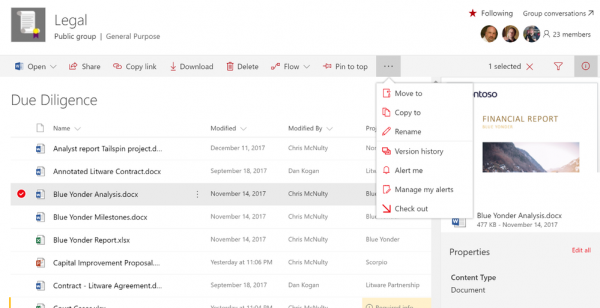Microsoft allows users to move files in Office 365 with full fidelity metadata and version management protections. Thus, if we look at the bigger picture, it helps ease up all the processes. Now, let’s look at how all things come together to make things easier.
Move files between Microsoft 365, SharePoint and OneDrive

If you want to move files across SharePoint this section of the tutorial will be the most helpful for you. The Move to command is really helpful in doing things.
- First of all, you have to select the list of files you want inside SharePoint.
- After selecting it, you must head to the Command Bar as shown in the screenshot above.
- In that command bar, select Move in order to move the file.
- After that, you will see a menu asking you to select the destination like shown in the figure below.
- This list of the target will show the targets that are relevant to your work. This is so just because it is powered by Microsoft Graph.

Now, just choose a location to move your file and click on Move Here. This will include your OneDrive locations, Office 365 Locations and more. You can choose a custom location if your desired target is not displayed.
Relevant Scenarios
These capabilities will be useful to an individual in many scenarios. Preserving minor details like metadata and version history matters to many people.
Migration:
Times are changing. Companies are migrating from native server-based systems or third-party services to reliable and better services like Office 365. Not all files are often properly migrated to these new locations, and some are left unaffected in older locations. Hence, provisions like this help the user maintain a proper record of files being migrated to these new solutions.
Sharing:
This is useful in scenarios when you have just completed a new draft of a file and wish to share it with your team.
Publishing:
If you want, you can also easily host it somewhere and share it with your audiences. This lets you increase your reach, and the higher the reach with reliable tools, the better the user experience.
Modernization:
If you bring some older files to a new site project website, you can do it by conserving attributes. Also, you can group files according to the type of user group it belongs to.
Multigeo:
Your legacy content can be moved to new sites in new geographies.
Along with this, the team at Microsoft also talked about some FAQs or Frequently Asked Questions. Here are some of them:
Frequently Asked Questions (FAQs)
File copy was rolled out over a while ago – does the new feature change anything with copying files?
For long-time followers of the cross-site Copy feature, you may be interested to know that cross-site move is built on the same API that also powers scenarios like migration, publishing, and point-in-time restore. As we roll out Move, we will remove the limit on the size of files and packages that you can Move or Copy.
As with Copy, you should be able to move files anywhere within your SharePoint tenants, allowing you to write files including sites in other geographies. The notable exception is that you will not be able to move or copy files out of Information Rights Management (IRM) enabled libraries.
How is the new feature different from Copy?
A few things to note that are different about Copy and Move:
- When files move, they will retain all their original versions from the source while Copy only delivers the final version of a file.
- When a file is moving, it will still appear in the source directory until its fully moved to the destination and then it will be deleted. The file will remain in the source sites recycle bin after the Move is complete and be subject to the normal recycle schedule unless a user recovers it from the recycle bin.
What happens if the target location doesn’t support metadata?
Moving files between libraries or sites preserves metadata by matching column names. If the destination does not have a matching column, metadata in the source column will be lost. In this case, you will be informed and prompted to confirm proceeding with the move and deleting the unmatched metadata. This is unlikely to happen when moving a file from your personal files (which do not currently support metadata) to SharePoint sites, but can happen when moving files between SharePoint libraries or sites with mismatched columns.
Administrators can reduce the incidence of this error by making sure that the columns on team sites are consistent across their team sites. In cases where that’s not possible, admins can give users guidance about how moves will impact metadata.
How does this work with Retention and Records Management?
If you are using data governance labels to control information policies for retention or records management, the policy labels applied to the source location must exist in the destination location. If the destination does not support policies applied to the file in the source, you will be blocked from moving the file, as doing so would circumvent retention or records management.
Finally, moving files already in a Records Center library will leave the source file in place, resulting in two copies of the file.
Can I move a OneNote notebook?
OneNote notebooks contain a grouping of many files. Moving a OneNote notebook will break the notebook into subsections and is not recommended.
You can read more about it in the official announcement post by Microsoft.
Read: How to block Bing Search installation in Microsoft 365.
Leave a Reply